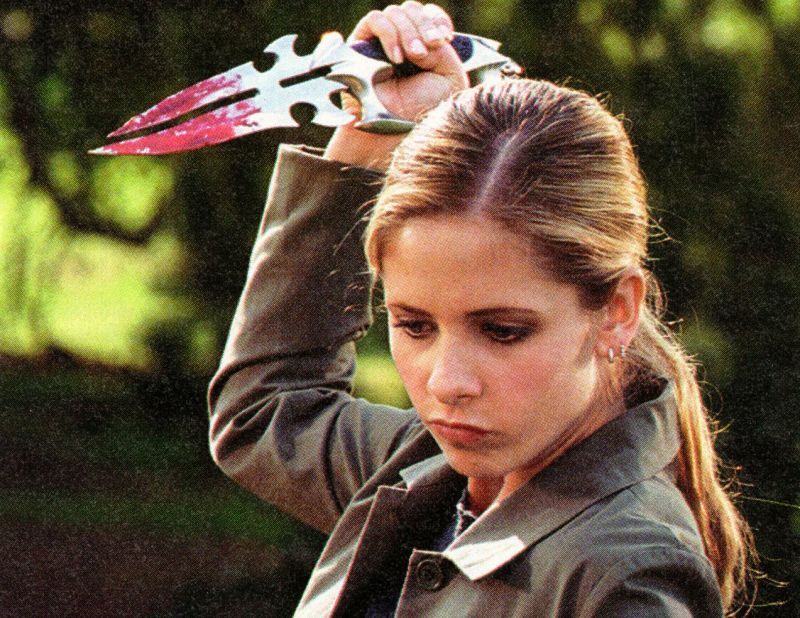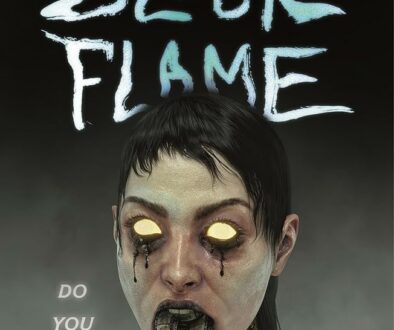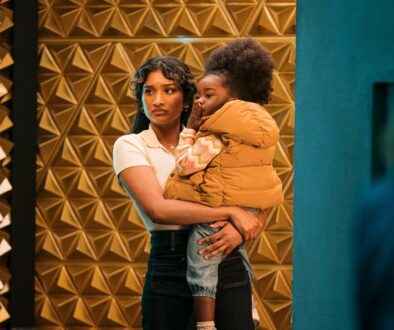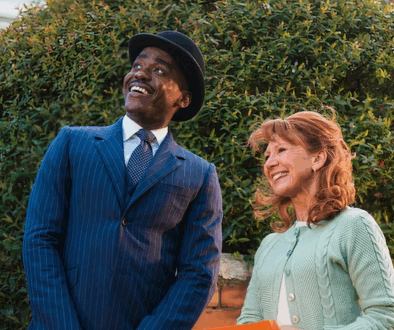The Genocide of the Vampires
 A guest post by Noah Berlatsky, from his new book The Hammer Dracula Films: And Other Vampires. Which is great stuff that you should check out.
A guest post by Noah Berlatsky, from his new book The Hammer Dracula Films: And Other Vampires. Which is great stuff that you should check out.
You can’t see a vampire in the mirror for the simple reason that the vampire is your reflection. The monsters onscreen are projections of human desires. Hammer audiences lick their fangs with Christopher Lee at all the delicious bosoms beckoning. Dracula pierces the exposed neck with a phallic oomph, just as the vampire hunter drives his rigid stake into the nubile beauty’s trembling form. Lust and blood drive both the living and undead; the population of Stephen King’s Jerusalem’s Lot is murdered by proliferating vampires, and then murdered again by the heroic vampire killers. First the vampires rage through the town like a consuming fire, and then, at the end of the book, they are themselves consumed. The same townspeople are destroyed once, then twice— as if the first time was so much fun it needed to be rewound and watched again.
In King’s Salem’s Lot (1976), the fact that the vampires are in fact, just us, is the point of the novel and its horror. King hates the people of Jerusalem’s Lot, and loves that hatred with the same vicious delectation of his vampire antagonist, Straker. The people in the town cheat on each other, loathe each other, lust after each other, betray each other and beat their children. They are squalid, loathsome, mean-spirited and ugly—King shines his narrative upon them, and they hiss and burn and thrash feebly, just like they do when they become vampires and are pulled out of their sleep and into the sunlight. As police chief Parkins says before he heads out of town, Salem’s Lot “ain’t alive…That’s why he came here.”
It’s dead, like him. Has been for twenty years or more. Whole country’s goin’ the same way. Me and Nolly went to a drive-in show up in Falmouth a couple of weeks ago, just before they closed her down for the season. I seen more blood and killin’s in that first Western than I seen both years in Korea. Kids was eatin’ popcorn and cheerin’ ‘em on.” He gestured vaguely at the town, now lying unnaturally gilded in the broken rays of the westering sun, like a dream village. “They prob’ly like bein’ vampires.”
The kids Parkins describe eagerly watching carnage on those movie screens are, of course, much like the kids eagerly turning the pages of Stephen King’s novel. The magic of the vampire narrative is that it reaches out and bites you, changing you into the fiendish antagonist you are supposed to hate and despise. Readers, like Parkins, wait with leering, moralistic satisfaction for evil to be done, and for the deaths that follow —first of the humans who are vampires, then of the vampires who are human. If you enjoy Salem’s Lot, then you all, along with those townspeople, “probl’ly like bein’ vampires.”
To like being a vampire is, first of all, to enjoy killing. But it’s more than simply enjoying the power, or the rush, of individual violence, as in a standard slasher film. In vampire films, murder is presented as a ritual sacrament; an (un)holy and sexual communion., When Louis finally switches from animal blood to that of a human child in Interview With the Vampire, it is presented as a sexual, moral, aesthetic rapture.
For four years I had not savored a human…and now I heard her heart in that terrible rhythm…I think I rose to my feet still locked to her, the heart pulling my heart faster with no hope of cease, the rich blood rushing too fast for me, the room reeling…
For a vampire, killing is not just a need, but a satisfaction. Christopher Lee, as Dracula, seems to positively enjoy cuckolding all those boring bourgeoisie and taking their women. Those squares deserve it, damn it. If you’re a vampire, murder is fun—and a good thing in its own right.
That’s not just true of vampires. For vampire hunters, too, each death is a boon. Buffy, the superhero charged with protecting the earth from the demonic hordes, has the title of Slayer. Vampires are evil, and each one she kills is a further testament to her goodness. In the Hammer films, vampire hunters are reluctant, uncertain: driving that stake through the heart of a prone vampire feels—well, like driving a stake through the heart of a sentient, human shaped creature. But Van Helsing, or someone like him, is always there to assure the wavering hero that the act of destruction is a necessity, a mercy, a heroic manly feat of love. Killing vampires is not evil. It’s virtuous.
Just as vampires kill and kill and kill again, so too do vampire hunters rarely stop with that first stake. If killing one vampire is good, then killing lots and lots of vampires is better. Murder, that vampire sacrament, is also a sacrament for humans fighting vampires. The more you kill, the better you are.
This is a good thumbnail description of the logic of genocide. People sometimes wonder how common folks can participate in genocides, or how mass killing can be justified. But watching Buffy, the justification is quite straightforward.
Vampires, in Buffy’s world, have no souls. A soul, here, is not a conscience, since many human beings lack consciences. Nor is a soul a synonym for goodness, since many human beings with souls aren’t good. In fact, vampires in Buffy’s world, or in any world, aren’t really much different from people; since vampires and humans alike murder and show every indication of enjoying doing so. By the same token in Buffy, the vampire Spike, sans soul, gives up killing and acts like a decent human being, at least for a while. Souls don’t tell you much about how someone will act, it turns out.
The fact that a vampire does not have a soul is less an indication of how the vampire will behave than it is an indication of how you are allowed to behave towards the vampire. A soul isn’t a sign that someone is a good person or a bad person. Rather, a soul in Buffy is a shorthand for moral standing. To kill someone with a soul is bad. To kill someone without a soul is good. And, just like that, genocide stops being an atrocity and becomes an act of heroism. Each death is an additional moral good—which, if you follow the logic through, leads you to Auschwitz. It’s not an accident that Nosferatu’s Count Orlok is a hook-nosed, rat-like anti-Semitic caricature.
Obviously, advocating vampire genocide isn’t the same as advocating Jewish genocide. Vampires aren’t real, and they aren’t Jews either. Yes Bram Stoker “was good friends with, and inspired by, Richard Burton, the author of a tract reviving the blood libel against Jews in Damascus” and he also “railed against degenerate writers for not being good Christians,” according to Judith Halberstam’s 1993 essay “Technologies of Monstrosity.” But, as Halberstam goes on to argue, while vampires are not, exactly, anti-Semitic caricatures, they function, or are put together, in much the same way as anti-Semitic caricatures.
Both vampires and anti-Semitic caricatures, Halberstam argues, “condense many monstrous traits into one body.” They both compound gender, ethnic, and class anxieties into a single figure of monstrosity and hate. Narratives of oppression, invasion, and defilement are mixed together, so that the destruction of the hated figure becomes revenge, cleansing purge, and orgiastic rejection of orgies. Vampires illustrate what happens when human beings are bitten by narrative and robbed of their souls. They become the undead, which is to say, they are people who can be rendered dead without sin.
The vampire genre, then, recreates the imagination, the pleasure, and the economy of stereotype, hatred, and extermination. It is about genocide—which isn’t to say that it always cheers genocide on. Richard Matheson’s I Am Legend (1954) is about the lone human left on earth after a vampiric plague. Robert Neville does what Buffy does—he kills vampires and kills them and kills them some more, on the grounds that each one is evil, and each death virtuous. The twist ending is his realization that he has, in vampiric fashion, become the thing he hates—a murderous archetype. “He was an invisible specter who had left for evidence of his existence the bloodless bodies of their loved ones.” The vampire hunter is a vampire—and so, as vampire hunter and vampire, he must kill himself.
Matheson questions the logic of genocide, but he doesn’t exactly provide an alternative. In I Am Legend, the recognition that vampires are morally equivalent to humans means that humans are morally equivalent to vampires. If killing vampires isn’t a good, then killing humans is; the exterminator and the exterminated simply switch places, so that instead of wiping out the vampires, Robert finishes the genocide of the human race by killing himself.
Stephenie Meyer, in contrast refuses to see the deaths of either vampires or humans as a good The vampires in Meyer’s world have souls in the sense discussed above—which is to say, Meyer’s vampires have, at least for the most part, moral weight. There are vampires who do terrible things, and vampires who are close to being saints, but whether saints or sinners, vampires are people. Murdering them is a moral wrong, not a moral good.
The Short Second Life of Bree Tanner, Meyer’s 2010 novella, is a brief, affecting summary of her refusal to follow through on the vampire trope of extermination. The book is told from the perspective of Bree Tanner, a minor vampire character killed in Meyer’s third Twilight novel, Eclipse. In most vampire narratives—Stoker’s, or Stephen King’s, or Whedon’s, or Anne Rice’s —Bree would simply be a way to pile up the body count, an extra dead monster, satisfyingly slain for the greater good.
Meyer acknowledges in her introduction that she looked at Bree that way at first too. “When I was writing the first draft of Eclipse,” she says, “I had first-person-perspective blinders on; anything that Bella couldn’t see or hear or feel or taste or touch was irrelevant.” Bree’s experiences, and soul, didn’t matter. But then, Meyer says, while editing, she rethought the character, and saw her as her own person, with her own story. “I hope you will end up caring about Bree as much as I do,” she concludes, “though that’s kind of a cruel wish.” Rather than feeling the rush of virtue at another dead monster, Meyer wants her readers to feel pain for Bree when she dies. As Meyer says, “no perspective is ever truly trivial.”
In her other Twilight novels, Meyer makes it easy to sympathize with her vampires. The Cullen clan doesn’t feed on humans—they’re good, heroic, self-abnegating vampires, so it’s not hard to root for them. Bree is different though. She is, at the beginning of the novella, a newly born vampire, only barely in control of her bloodlust. Practically the first thing she does in the novella is kill a woman, with great eagerness and no remorse. “She opened her mouth to scream,” Bree thinks, “but my teeth crushed her windpipe before a sound could come out.” Bree kills a lot of other humans before her story comes to an end, too. She’s a mass murderer.
It’s significant that the first woman Bree kills is a sex worker; Bree singles her out specifically because she knows that people on the margins of society aren’t likely to be missed or mourned. Similarly, Riley, the vampire who kidnaps Bree to turn her, picks her out because she is a starving runaway. “I figured I knew what he would want in exchange for the meal,” Bree thinks, “and I would have given it to him, too. Not because he was so pretty to look at, but because I hadn’t eaten anything but trash for two whole weeks.” Bree, who feeds on a sex worker, is herself a sex worker, at least in intent, when she is fed upon. Human and vampire are the same—not because both are murderers, but because both are victims. They are both devoured in large part because society has decided it doesn’t care if they’re devoured.
Bree doesn’t make this connection herself; she barely thinks at all about the humans she kills. But the fact that they are killed off to the side, with little fanfare, only makes them more like Bree, who was herself a mere blip in the Twilight series, killed off to the side, with little fanfare. Meyer doesn’t tell you anything about the sex worker. But by filling in Bree’s story, Meyer implicitly acknowledges that the people Bree kills have stories too. In the Hammer films, or Salem’s Lot, or The Interview With the Vampire, deaths are, primarily, instrumental—humans are killed to show how vicious, remorseless, evil, sexy, and/or cool the vampires are. But Bree’s story is about the fact that people who die off to the side aren’t off to the side in their own stories. The woman who Bree kills is a soul in her own right, even if we don’t know her.
If this is true of humans, it’s true of vampires too. Riley, who kidnaps Bree, also kidnapped another vampire, named Diego, with whom Bree falls in love. Though Riley and Diego are friends, of a sort, Riley kills him at the command of Victoria, the vampire who created him, and who is preparing the newborns for a war on the Cullens.
After she learns that Riley killed Diego, Bree is unapologetically, and understandably glad to hear that the Cullen clan has killed him in turn. She is vengeful and vindictive, and the reader is on her side; Riley is the novel’s bad guy. But again, if there’s more to Bree’s story than we learn in Twilight, it follows that there’s more to Riley’s story than we lean in Bree Tanner.
Bree acknowledges as much. “I believed only one thing that Riley had ever told me: he had valued Diego more than [he had valued] any of the rest of us. Had even been fond of him. And yet he’d watched our creator hurt him. No doubt he’d helped her.” Riley is, again, the bad guy; torturing your friend to death qualifies as evil from just about any perspective. But the narrative takes a moment to acknowledge that he’s not just evil. Riley was only turned into a vampire a few months before Bree. Who was he before he changed? What did Diego mean to him? We don’t know—but even in celebrating his death, Bree acknowledges that there is something to know. Meyer probably isn’t going to write The Short Second Life of Riley. But she could. Murdering a murderer is still a murder. Diego killed a lot of people too; if we should mourn his death, why shouldn’t we mourn Riley’s?
During the final battle with the Cullens, Bree offers to surrender. The Cullens argue back and forth whether to let her live. Jasper is worried that saving her will get the clan in trouble with the Volturi, a kind of vampire police force, who strictly regulate the creation of newborns. But Esme, the Cullen’s mother figure, insists that murdering Bree out of expedience is unacceptable. “We can’t just murder her in cold blood!” Esme insists, flying in the face of basically every vampire story ever. Bree is fully aware that Esme’s argument goes against the genre tropes. “It was strange to hear her speak like we both were people,” she thinks, “like murder was a bad thing. An avoidable thing.”
Esme wins the argument. The Cullen clan refuses to dehumanize Bree, and so refuses to kill her. Even though she is a vampire, her death is not a good. If vampires are people, the logic of genocide can’t hold.
Ultimately Bree is murdered—not by the Cullens, but by the Volturi. As Jasper anticipated, the Volturi believe that Bree’s existence violates the rule that vampire newborns can’t be sired in large numbers. Since Bree was created as part of an army, her life if forfeit. The Cullens offer to take Bree in and teach her, but the Volturi just laugh at the idea. Bree to them is a mistake, a blot. Rubbing her out is required by the rules; it’s the ethical thing to do.
Inevitably, many readers see the Volturi, in turn, as blots who it would be best to remove. Throughout the novels, the Volturi kill humans and vampires alike without compunction, and even with glee—one of the bloodiest scenes in the series involves the Volturi luring and then feasting upon a group of tourists in their native Italy. As critic and writer Arthur Chu told me on twitter, “The Volturi slaughter humans for sport and the protagonists do nothing about it.”
In most vampire literature, or most pulp literature, large scale violence makes you fair game for violence yourself—it means that destroying you is good, and, often even exhilarating. “We came, we saw, he died,” Hillary Clinton exulted after Libyan leader Colonel Qaddafi was killed in an airstrike. Qaddafi was a mass murderer who was, Clinton believed, going to go on hurting people if not stopped. He was one of those Volturi; his death was righteous, and to be celebrated. But as the debacles in Iraq and then Libya demonstrated. Violence is hard to contain. Once you start treating people as vermin, it can be difficult to stop.
Rejecting genocide, for Meyer, doesn’t mean that death and violence disappear. The Cullens aren’t superheroes; they don’t save everyone and make everything right. They kill in self defense, when they or those they love are threatened. But they can’t fight every battle, and while they’re willing to plead for Bree, they’re not willing to die, or kill, for her. Treating vampires as people, and for that matter, people as people, doesn’t usher in a utopia of sweetness, light, and nonviolence. It does, though, allow the Cullens to see killing as an evil, rather than a positive good—which means that morality for them means killing less, rather than, as with Buffy or Van Helsing or the Volturi, killing more. The Cullens, as Carlisle says, “don’t take lives lightly.”
Not taking lives lightly means not taking any lives lightly—not even the lives of the Volturi. Many of the Cullens hate many of the Volutri personally, and they find their murderous violence repugnant. But still, the Volturi have souls, and killing them, like killing anyone, is unethical.
Pulp logic, and the related logic of humanitarian intervention, presents this decision as vile and culpable; when you see injustice and you have super powers (or you are a super power), you should swoop in to stop it.
But if you think about it for a moment, it’s far from clear that the Cullens’ decision is the wrong one. An all out conflict of vampires against vampires would be horribly destructive—not least because it could easily reveal the existence of vampire-kind, and lead to a final showdown between vampires and humans. Once you set foot on the path to war, you set foot on the path to total war, and not infrequently on the path to genocide. The Cullens, unlike Buffy, or Van Helsing, or Hillary Clinton, or just about every pulp hero in existence, refuse to use a righteous cause to justify the first murder, or the second, or all the others.
It’s easy to mock Meyer’s vision of sparkly Christ-figure vampire do-gooders, and many have. For that matter, the whole notion of Christian righteousness vis-à-vis filthy bloodsuckers is given a vampiric snort and giggle by the 2001 B-movie schlock joke, Jesus Christ: Vampire Hunter. In the film, Jesus himself (Phil Caracas) sets aside the whole turning-the-other-cheek nonsense, and sets about giving a kung-fu whupping to a swarm of vampires terrorizing the lesbian community of Ottawa. Teamed up with Mexican luchador Santos (Jeff Moffet), the son of God uses his carpentry skills to carve some mean stakes, and beats his opponents so badly even the atheist shouts, “I don’t believe it!” before adjusting her breasts for the attack.
Jesus Christ: Vampire Hunter is deliberately, joyfully ersatz; the whole film is badly dubbed, the acting is stiff, and the plot makes only vague, half-hearted gestures at coherence. There’s one full-on, camped up musical number, where Jesus races around healing the sick and skateboarding. The kung-fu choreography is exceedingly half-assed, reaching an apotheosis of absurdity in the final battle, when the evil Dr. Praetorious (Josh Grace) battles Jesus with vivisected-lesbian intestines. Vampire genocide—as not infrequently in Buffy— is a (bloody) gag. The film takes campy joy in its lack of verisimilitude; it cheerfully embraces its fantasy as fantasy. Vampires walk the earth; Jesus wipes them out. Who wouldn’t want to live in that world?
The central fantasy of JC:VH isn’t the fiction of righteously murdering all your enemies, though. Rather, it’s the dream that the Catholic Church, and Jesus Christ himself, really cares about queer people. When Jesus tells Mary he’s protecting lesbians, Mary, speaking through a glowing plastic image of herself, responds, in Jewish mother mode, “Oh, God loves them. They get so much done in a day, don’t you think?” And when the evil vampire explains that they’re killing lesbians because no one will miss deviants, Jesus says, “There’s nothing deviant about love.”
Those lines are jokes. But they’re wistful jokes. Jesus should care about the genocide of queer people—even though he, or at least many of his worshippers, did not care about the AIDS crisis. And if Jesus cares about genocide by blood infection, that means he should care about the genocide of vampires too. The vampires are killing lesbians in order to steal their skin, graft it on themselves, and gain protection from sunlight. That means that vampires are vampire/lesbian cyborgs; they’re the same people.
And sure enough, Jesus has compassion left over for the vampires who are lesbians too. Jesus stakes Mary Magnum (Maria Moulton), an ally-turned-vampire. But he’s Jesus; he can undo any genocide he perpetrates, and so he brings Mary back to life. Mary then in turn begs Jesus to heal chief vampire Maxine Shreck (Murielle Varhelyi), who it turns out, is the love of her life (she admired her outfit on first sight.) Jesus is a little unsure about resurrecting Maxine, but he gives in—and he also resurrects Santos’ love, Maggie (Erica Murton.) “Aren’t you a lesbian?” Jesus asks coyly when Maggie comes back to life and is snuggling with Santos. “No,” she replies. “I’m bi!” At which Santos raises his arms and bellows in enthusiasm, because bisexuality, like lesbianism and resurrection, is awesome.
Buffy and Van Helsing supposedly, have no choice when they kill. The vampires they face are demonic parasitical beast; they have to be destroyed, like Qaddafi, lest they wreak havoc evermore. And within their respective fictional worlds, this is true; vampires are monsters with no soul. But the key term there is “fictional”: vampires aren’t real. As Twilight and Jesus Christ: Vampire Hunter show, a vampire story doesn’t have to be about the virtues of killing. It can be instead about mercy, resurrection, sparkles and silly kung-fu. To create vampires who are irredeemably evil, therefore, is to choose to believe in a world in which one’s antagonists are not people, but vermin, who must be exterminated. It’s to look in a mirror and refuse to see a living soul.
If you enjoy Noah’s work, and you’d be nuts not to, you can support him on Patreon. It’s almost as good an idea as supporting Eruditorum Press there.





November 22, 2016 @ 6:28 pm
”Both vampires and anti-Semitic caricatures, Halberstam argues, “condense many monstrous traits into one body.”
I don’t know if you’ve ever seen Zizek’s ‘Pervert’s Guide to Ideology’. In demonstrating how ideology feels free to contradict itself he looks at anti-semitic propaganda films from the Nazis. In which “the Jew” can be a repulsive feral creature, living in filth and speading disease, and at the same time a rootless cosmopolitan, suavely seducing poor innocent German girls.
And what’s interesting is that the vampire also embraces that contradiction. It can veer between the two poles, where Orlok is a feral moster and Christopher Lee’s Dracula is a caped count. But the other pole is always in there.
November 23, 2016 @ 1:33 pm
Great article. I’ve been guilty of mocking the Twilight franchise in the past, but this makes me actually want to return to it and read it from a different perspective.
Not only is there a stigma within fictional worlds about humanizing vampires, but a stigma about how such narratives are received: a story which depicts them as anything more than monstrous and disposable is immediately considered weak/foolish and often dismissed. Merely questioning systematic violence against the “soulless other” leaves the author open to mockery.
Black Mirror’s “Men Against Fire” illustrated similar ideas as well.
November 24, 2016 @ 9:01 am
My personal theory is that this stigma is placed first and foremost on narratives authored by women. I might be wrong, but I feel like this shift in depictions of vampires came with Anne Rice and Chelsea Quinn Yarbro – seen from a male perspective, a foreigner doing naughty things to women with his mouth is a threat that must be destroyed. From the perspective of a woman, however…
This, for me, is the primary grounds on which later narratives, such as Twilight, are attacked.
January 3, 2017 @ 10:17 pm
I guessed the “Men Against Fire” twist before the episode had even finished setting up all the elements of the status quo it was going to subvert, but I was surprised by how succinctly Charlie Brooker summarized the ethos of these works of man-vs.-monster horror media in a line from one of the characters:
“You can’t still see them as human. Understandable sentiment, granted, but it’s misguided.”
Even when the storytelling displays grief and compunctions over this decision (as with most “serious”, “realistic” zombie fiction of the past few decades), it’s still fundamentally about using fantasy tropes to valorize the capacity to mentally categorize certain people as not-actually-people, which rarely if ever leads to anything in real life that isn’t utterly abominable.
April 15, 2017 @ 6:05 pm
One of the most interesting essays I’ve ever read. Thank you.
I wonder, though. If you reject the logic of genocide, if you decide that killing people is never a moral good… well, what exactly do you do about the problem of vampires? Or Quaddafi, for that matter? If killing mass murderers is wrong – and I believe it is – then what do you do about them? How do you stop people who kill other people? Or do you just let that happen, like we do with North Korea?
I don’t have the answer myself. I hate killing, I wish nobody ever killed. I just don’t know what the alternative is. Sitting down to talk and finding common ground doesn’t always seem to be an option.